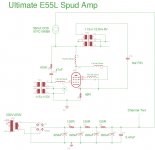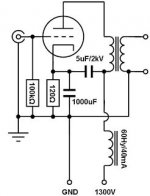The classic ECL86 of course. Half EL84 (almost), half ECC83.
They are expensive, but you can get PCL86 , or the soviet equivalent.
They are expensive, but you can get PCL86 , or the soviet equivalent.
Consider one on the plate pin if you haven't already.thanks shoog
ferite beads are everywhere 1K grid stopper and 100R between plate and screen , i don't suspect oscillation symptom just a damn fast tube🙂
lundahl AM transfo didn't help rounding the edges.. i will see how it goes with the Monolith Magnetic iron
I know what you mean regarding the E55L brightness, I suspect that its due to its really low rp which drives the parasitics better than most SE valves. I have always said that what people report as the SE sound is largely an inability to drive the iron flatly out to beyond 20khz (ie a rolled off response). Is there a recommended zobel for the Lundahl iron to tame resonances ? I have found that resonances out beyond 30khz can cause the sort of sound you are describing.
Shoog
6HS5 for VinylSavor spud 8 watts amplifier build in single version.
Few components short signal path.
VinylSavor: 6HS5
B + are more 1KV
 😀
😀
Greetings
Few components short signal path.
VinylSavor: 6HS5
B + are more 1KV

 😀
😀Greetings
Attachments
very interesting shoog , no resistor between plate and screen , paraded bypass cathode resistor. i just don't understand the wiring of your input transformer secondary and the 470K 47n filter from power supply to the grid ?
sound happy do you want me dead ?
sound happy do you want me dead ?
B + are more 1KV
The input transformer is simply acting as a autotransformer/grid choke with 1>2 step up, not strictly necessary as I find the gain excessive anyway.very interesting shoog , no resistor between plate and screen , paraded bypass cathode resistor. i just don't understand the wiring of your input transformer secondary and the 470K 47n filter from power supply to the grid ?
sound happy do you want me dead ?
The cathode doesn't need a bypass because the current from the parafeed cap is balanced by the cathode current yielding a zero signal at the cathode (this is a very old trick from the early days of valves).
The screen resistor is mainly there to damp resonances and excessive current in a Class AB situation - since this is a Class A design the current should never peak dangerously so needs no dropper resistor to protect it, the ferrite bead is good enough to prevent oscillation by itself.
The 470K is there to offer a tiny amount of Schade feedback and can be tuned to taste anywhere from 10K up.
Shoog
Last edited:
Soundhappy do you want me dead ?
Interesting tube and topology but you are aware about high danger 😱

Shoog, I think I read somewhere that beads are designed to work in specific frequency ranges. If so, what type bead should be used? Regards, HeyBill
I just used salvaged beads from an old Fostex DAT recorder. They consist of a single loop in a rectangular block. They will have a low pass knee and will block everything above that knee.Shoog, I think I read somewhere that beads are designed to work in specific frequency ranges. If so, what type bead should be used? Regards, HeyBill
The issue with these high gm valves is that they have extremely low capacitances and they are designed to work at very high frequencies, the combination of low input capacitance’s, line capacitance’s and inductance’s are liable to turn any lead attached to the pin an antenna for any stray radio frequencies or stray signals from switch mode power supplies or diode spikes in the PSU. The bead just needs to isolate the line from the valve.
Shoog
thanks for the tip shoog this morning i have removed the 100R resistor between plate and screen and put a little ferrite bead instead and change the 1K metal film grid stopper resistor with 300R tantale . no oscillation and sounds good too ( like before ) 🙂
Last edited:
Try a very simple single loop ferrite on the g1 and see if it softens the sound any.thanks for the tip shoog this morning i have removed the 100R resistor between plate and screen and put a little ferrite bead instead and change the 1K metal film grid stopper resistor with 300R tantale . no oscillation and sounds good too ( like before ) 🙂
It might.
Shoog
Your right, but its beyond my knowledge.Shoog, I think I read somewhere that beads are designed to work in specific frequency ranges. If so, what type bead should be used? Regards, HeyBill
Shoog
Try a very simple single loop ferrite on the g1 and see if it softens the sound any.
It might.
Shoog
i have already tried , no change at all with grid stopper resistor in place.
after long classic listening i have found that the sound is even better with no resistor between plate and screen ( more pop up dynamics and less grainy) . the lundhal iron don't help i have sold the 1664AM and keep the normal version because of this. i had softer sound with the James 3.5k transformer but with the loss of bandwidth and definition.
no free lunch again 🙂
6HS5 for VinylSavor spud 8 watts amplifier build in single version.
Few components short signal path.
VinylSavor: 6HS5
B + are more 1KV
😀
Greetings
Interesting.
I my estimation absolutely not, very demanding on g1 drive which puts it out of the running.Is 812A doable as spud? medium mu..
Shoog
Member
Joined 2009
Paid Member
put a source follower in front of g1 maybe
is this doable :
source foll.+some schade😕😀 >=800Va
In that shape, would it be nice to listen?
The 6Z52P can also be used as a spud tube.
It has an anode dissipation of 10 Watt and a transconductance of 55 mA/V.
Kind regards
Frank
It has an anode dissipation of 10 Watt and a transconductance of 55 mA/V.
Kind regards
Frank
- Home
- Amplifiers
- Tubes / Valves
- Best Tube for SPUD Amp

